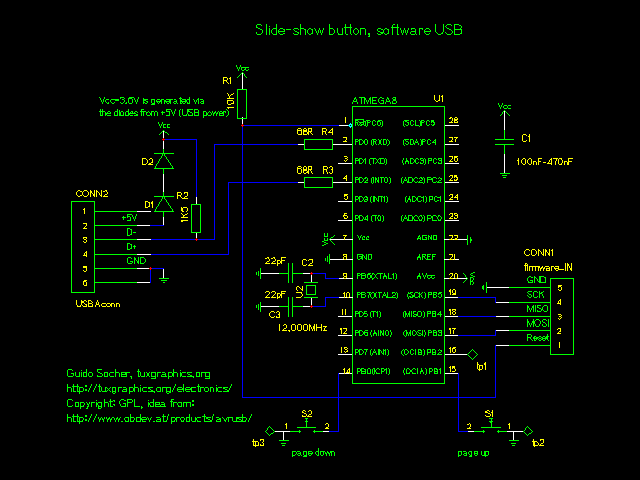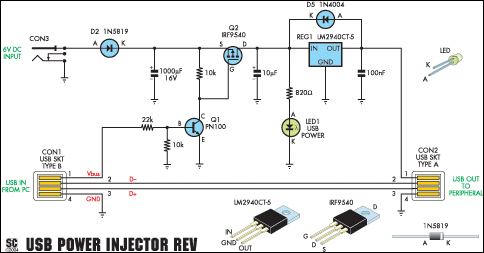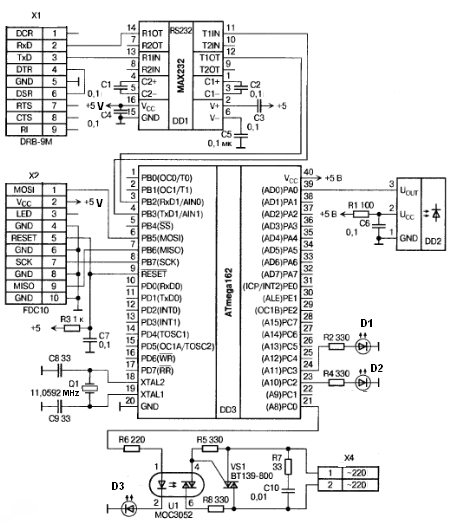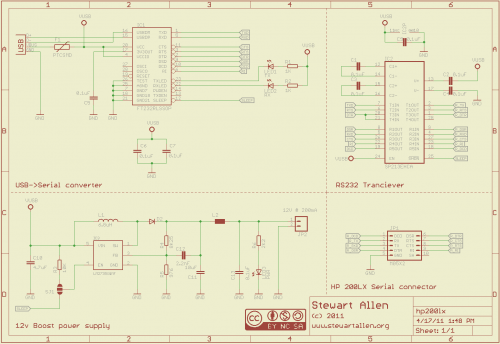
avr usb slideshow presenter.

USB HID is a specification that encompasses devices such as mice and keyboards. It features a GPL-based driver that allows the implementation of USB on an AVR microcontroller without the need for specialized hardware. Additionally, there is the AVR309 software USB application note from Atmel. The origins of this technology remain unclear, whether it was first developed by Atmel, the team at obdev.at, or another entity. Regardless, the team at obdev has created an excellent library that is user-friendly and includes numerous examples. This library operates reliably and effectively. The software-only USB implementation is classified as a low-speed device, which means it cannot support USB storage functionality; however, it is ideal for USB HID applications. The USB connector utilized is a standard USB-A connector with four pins, but the design incorporates the outer USB shielding, resulting in a representation of a six-pin connector in the schematic. Test points TP1, TP2, and TP3 are included for development purposes, with TP1 used for testing and TP2/TP3 providing a grounded metal plane near the buttons to enhance ESD protection for the hardware. This "slide show presenter" was enjoyable to construct, with the software emulating a HID keyboard that operates immediately without the need for special software or drivers. It is compatible with various operating systems, including Windows, Linux, Mac, and BSD. Simply connect the USB connector, wait a few seconds for USB bus enumeration, and begin using the slide show. This compact presenter works seamlessly with any presentation software, such as PowerPoint or OpenOffice.
The USB HID (Human Interface Device) specification allows for the integration of input devices like keyboards and mice into computer systems using a standardized protocol. This design utilizes an AVR microcontroller, which is programmed to recognize and respond to HID commands. The GPL-based driver facilitates the communication between the microcontroller and the host computer, enabling the device to function without additional hardware requirements.
The AVR309 application note from Atmel serves as a valuable resource for developers, providing guidelines and examples for implementing USB functionality within AVR microcontrollers. The library developed by obdev enhances usability, featuring a wealth of examples that demonstrate various HID applications, making it accessible for both novice and experienced developers.
In this design, the USB-A connector, typically featuring four pins (VCC, D-, D+, and GND), is enhanced by including additional shielding, represented as a six-pin connector in the schematic. This design choice not only improves mechanical stability but also aids in electromagnetic interference (EMI) protection. The inclusion of test points TP1, TP2, and TP3 is crucial for development and debugging. TP1 allows engineers to monitor signals during testing, while TP2 and TP3 provide a grounded plane that mitigates electrostatic discharge (ESD) risks, enhancing the overall robustness of the hardware.
The slide show presenter operates by emulating a HID keyboard, allowing users to control presentation software seamlessly. The device is designed for plug-and-play functionality, requiring no additional drivers or software installations on the host system. It is compatible with major operating systems, ensuring versatility across different platforms. Upon connecting the USB device, it undergoes enumeration, establishing communication with the host system within seconds, allowing users to begin their presentations immediately.
This compact and efficient design showcases the potential of USB HID applications, demonstrating how simple microcontroller-based solutions can enhance user interaction with digital content. The reliability and ease of use make this slide show presenter an attractive option for educators, business professionals, and anyone who frequently uses presentation software.USB HID is a specification that includes things like mouse and keyboard. has a GPL based driver to implement USB in an avr microcontroller without specialized hardware. There is also the AVR309, software USB application note from Atmel. I don`t know who invented it first Atmel or the people from obdev. at or somebody else. In any case the people from obdev. at have done a great job. It is an easy to use library with a large number of examples. It works perfect and is very reliable. Software only USB is a low speed device. You can`t implement usb-storage with it but it is perfect for usb HID. The USB connector is a standard USB-A connector with 4 pins but I wanted to use the outer USB shielding also. It is therefore drawn in the diagram as a 6 pin connector. TP1 was used for tests during development and TP2/TP3 are there to have a ground connected metal plane near the buttons for ESD protection of the hardware.
It was fun to build this "slide show presenter". The software emulates a HID keyboard and works out-of-the-box without requiring any special software or driver. You can use it under Window, Linux, Mac, BSD. Just plug the USB connector in, wait a few seconds for the enumeration on the USB bus and start your slide show.
This little presenter works with any presentation software. Powerpoint, OpenOffice, . you name it. 🔗 External reference
The USB HID (Human Interface Device) specification allows for the integration of input devices like keyboards and mice into computer systems using a standardized protocol. This design utilizes an AVR microcontroller, which is programmed to recognize and respond to HID commands. The GPL-based driver facilitates the communication between the microcontroller and the host computer, enabling the device to function without additional hardware requirements.
The AVR309 application note from Atmel serves as a valuable resource for developers, providing guidelines and examples for implementing USB functionality within AVR microcontrollers. The library developed by obdev enhances usability, featuring a wealth of examples that demonstrate various HID applications, making it accessible for both novice and experienced developers.
In this design, the USB-A connector, typically featuring four pins (VCC, D-, D+, and GND), is enhanced by including additional shielding, represented as a six-pin connector in the schematic. This design choice not only improves mechanical stability but also aids in electromagnetic interference (EMI) protection. The inclusion of test points TP1, TP2, and TP3 is crucial for development and debugging. TP1 allows engineers to monitor signals during testing, while TP2 and TP3 provide a grounded plane that mitigates electrostatic discharge (ESD) risks, enhancing the overall robustness of the hardware.
The slide show presenter operates by emulating a HID keyboard, allowing users to control presentation software seamlessly. The device is designed for plug-and-play functionality, requiring no additional drivers or software installations on the host system. It is compatible with major operating systems, ensuring versatility across different platforms. Upon connecting the USB device, it undergoes enumeration, establishing communication with the host system within seconds, allowing users to begin their presentations immediately.
This compact and efficient design showcases the potential of USB HID applications, demonstrating how simple microcontroller-based solutions can enhance user interaction with digital content. The reliability and ease of use make this slide show presenter an attractive option for educators, business professionals, and anyone who frequently uses presentation software.USB HID is a specification that includes things like mouse and keyboard. has a GPL based driver to implement USB in an avr microcontroller without specialized hardware. There is also the AVR309, software USB application note from Atmel. I don`t know who invented it first Atmel or the people from obdev. at or somebody else. In any case the people from obdev. at have done a great job. It is an easy to use library with a large number of examples. It works perfect and is very reliable. Software only USB is a low speed device. You can`t implement usb-storage with it but it is perfect for usb HID. The USB connector is a standard USB-A connector with 4 pins but I wanted to use the outer USB shielding also. It is therefore drawn in the diagram as a 6 pin connector. TP1 was used for tests during development and TP2/TP3 are there to have a ground connected metal plane near the buttons for ESD protection of the hardware.
It was fun to build this "slide show presenter". The software emulates a HID keyboard and works out-of-the-box without requiring any special software or driver. You can use it under Window, Linux, Mac, BSD. Just plug the USB connector in, wait a few seconds for the enumeration on the USB bus and start your slide show.
This little presenter works with any presentation software. Powerpoint, OpenOffice, . you name it. 🔗 External reference





